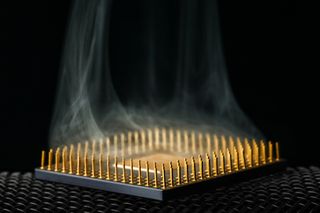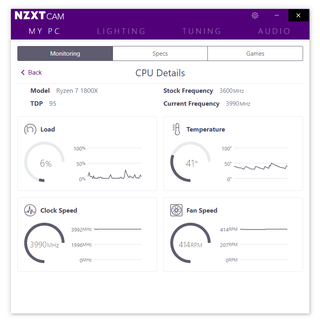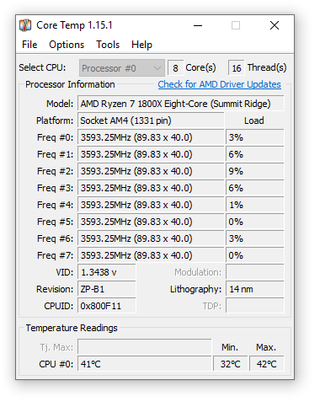
Checking your system's CPU temperature is similar to checking your car's oil: You don't need to do it daily, but it's something to keep an eye on every few months, especially if you regularly strain your system with higher loads.
Luckily, checking your CPU temperature is pretty easy and doesn't require you to open up your PC and stick a thermometer inside. Instead, every CPU comes with digital thermal sensors built-in, so all you need is a bit of software to read their measurements.
Below we'll break down what a healthy range of temperatures is for a CPU, how to check your CPU temperature and what to do if your CPU's temperatures are too high.
What's a Good CPU Temperature?
When the CPU is idle, or not being used by any program, a healthy temperature is anything under or around 50 degrees Celsius (122 degrees Fahrenheit). Under higher load, such as when playing a game, rendering a video, or other intensive tasks, your CPU consumes more power and, thus, runs at a higher temperature. This is more important than idle temperatures (assuming idle temps are fine) and you'll want to periodically monitor your CPU temperature under load to ensure it's adequately cooled during such conditions.
Under load, you want your CPU to ideally stay under 80 degrees Celsius (176 degrees Fahrenheit), though some CPUs may run hotter when they're in ultrabooks, gaming laptops, or small-form-factor (SFF) computers. You have some wiggle room to creep past 80 degrees Celsius, but anything above 95 degrees Celsius (203 degrees Fahrenheit) is critical. At this point, some CPUs will begin throttling, meaning the clock speed will slow down to ensure it doesn't overheat, and your PC may turn off.
More advanced users who want the utmost confidence that their CPU can handle aggressive workloads should stress test their CPU to 100% using a program like Prime95 or AIDA64 . When running such a stress test, keep a close eye on the temperatures, using the tools mentioned below, and back off once they reach too high a number, i.e. anything above 95 degrees Celsius. We consider an ideal stress test to be one hour long, though your maximum temperature will likely level off after 10-15 minutes.
How to Monitor Your CPU's Temperature
Checking your CPU temperature is as easy as firing up a monitoring program and using it to read out the value. Examples of these programs are HWMonitor, Core Temp, or NZXT's CAM. These three are just a few examples of many, and for the purpose of this how-to we'll show you how NZXT's CAM and Core Temp work because we have found that these two are the easiest to use for casual purposes.
CAM is developed by PC case, power supply and CPU cooler manufacturer NZXT. While it's intended to be used with their product, it works really well as a casual monitoring tool even if you don't own any NZXT hardware.
Once installed, CAM offers a well-presented user interface (UI). The first block features the CPU's status, which shows the load, temperature, clock speed and cooler fan speed. You can click on this block to access further details, as shown in the image below.
As you can see, the current temperature of this system's CPU is 41 degrees Celsius, which is a healthy idle temperature.
CAM also has an overlay, which automatically turns on when you enter a game when CAM is running. This overlay can show you your CPU's status while in-game, providing you with load temperature measurements.
You can also use the Core Temp tool to monitor the temperatures, which is a simpler tool that works with a more basic UI. Just be sure to untick the freeware in the installation menu first. 
As you can see, this CPU has been running at a temperature of 46 degrees Celsius and a maximum of 75 degrees Celsius (167 degrees Fahrenheit) and is, therefore, running at a normal temperature. The stress test temperature was achieved by running Prime95 for about 30 minutes, though the CPU hit its maximum temperature of 75 degrees Celsius within 10 minutes.
With Core Temp, the best way to monitor your temperature while gaming is to just have a good session, and then check back in with the program to see what the maximum recorded temperature is. Again, if this figure is at or beyond 95 degrees, you should be concerned. Anything between 80 and 95 degrees may have room for improvement.
What Should I Do if my CPU Temperature Is too High?
If under load your CPU temperature is exceeding 80 degrees Celsius, you should check your system to ensure the CPU's cooling is adequate.
Here's a checklist of things to look for:
- Is your PC clean and free of dust (including radiator)?
- Are all your PC's fan's spinning under load?
- How old is your PC?
- When was the last time you applied fresh thermal paste between your CPU and CPU cooler? If it's been over three years, consider re-applying the thermal paste.
- Does your model CPU cooler specify a higher cooling capacity than your CPU's rated TDP?
- Are you using a SFF PC, too small of a CPU cooler or a laptop?
For SFF PCs and laptops, it's possible that there's minimal cooling, as the device was never intended to be used under high loads for extended periods of time. For example, most laptops come with very compact cooling solutions that work well for short term performance bursts but need to slow down during extended gaming sessions to stay below the shut-off threshold. Gaming laptops are often bulky because they're packed with extensive cooling systems.
If you are using a full-size gaming PC, however, and think your cooling should be adequate, you may want to re-apply thermal paste to your CPU. Most thermal paste's performance seriously degrades after about three years. Applying fresh paste and cleaning the system from dust can offer much better cooling power and significantly better performance. This applies both to pre-built and custom-built PCs.